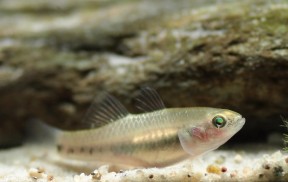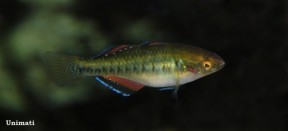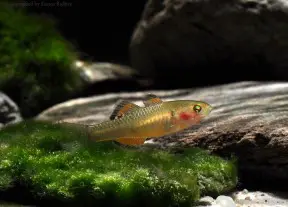Hypseleotris compressa
Empire Gudgeon
SynonymsTop ↑
Eleotris compressus Krefft, 1864; Eleotris brevirostris Steindachner, 1867; Eleotris modesta Castelnau, 1873; Eleotris compressus Macleay, 1878; Eleotris simplex Castelnau, 1878; Eleotris reticulatus Klunzinger, 1879; Eleotris elevata Macleay, 1881; Eleotris cavifrons De Vis, 1884; Eleotris humilis De Vis, 1884; Eleotris devisi Ogilby, 1897; Carassiops longi Ogilby, 1897
Etymology
Hypseleotris: from the Greek hypsos, meaning ‘height’, and the generic name Eleotris.
compressa: from the Latin compressus, meaning ‘compressed’.
Classification
Order: Perciformes Family: Eleotridae
Distribution
Occurs in northern and eastern Australia and southern New Guinea.
In the former its range extends from the Pilbara and Kimberley regions of Western Australia state around the northern and eastern coastlines of the continent as far as the Towamba river system in New South Wales state.
Type locality is ‘Clarence River and creeks near Port Denison, Australia’.
Maximum Standard Length
100 – 120 mm.
Aquarium SizeTop ↑
Minimum base dimensions of 80 ∗ 30 cm are recommended.
Maintenance
Provide plenty of hiding places and cover, the idea being to create broken lines of sight to allow weaker individuals to escape continual attention from dominant fish.
Filtration need not be strong with an air-powered sponge-type unit ideal.
Water Conditions
Temperature: 20 – 35 °C
pH: 5.0 – 9.1
Hardness: 36 – 447 ppm
Diet
Feeds chiefly on a range of small invertebrates, crustaceans and similar in nature.
In the aquarium it should be offered small live or frozen foods such as chironomid (bloodworm) or mosquito larvae, Artemia, Daphnia, Mysis, etc., although dried foods are normally accepted as well.
Reproduction
Rarely achieved in aquaria and this is undoubtedly attributable to its complex amphidromous breeding strategy.
In nature adults live and spawn in freshwater streams but the initially pelagic post-hatch larvae are washed downstream to the sea where the post-larval fry spend the first part of their life developing in marine conditions.
Once maturity is reached the fish will spawn readily in aquaria with males intensifying in colour and attempt to entice females to spawn with them whilst defending their chosen territory against other males.
Up to 3000 tiny eggs are laid on a pre-cleaned solid surface which may be a rock, piece of driftwood or even the aquarium glass.
Post-spawning the female is rejected and the male assumes sole responsibility for brood care.
Incubation is around 24 hours and in the natural life cycle the fry would now be carried to the sea, where they feed around the coast and in estuaries before returning to freshwater to spawn themselves.
Provision of such conditions plus the tiny size of the post-hatch larvae thus present serious problems for the aquarist.
The larvae initially have no alimentary tract or rayed fins initially and are even unable to accept infusoria-type foods.
References
- Allen, G. R., H. Midgley and M. Allen, 2002 - Western Australian Museum: i-xiv + 1-394
Field guide to the freshwater fishes of Australia.






January 5th, 2016 at 10:56 pm
‘ello! One australian vendor reported successfully raising fry from this fish in an outdoor brackish pond…should’ve expected the adults to be brackish tolerant considering their range 🙂 Anyhow, here’s the link:
http://www.aquagreen.com.au/plant_data/Hypseleotris_compressa.html
Also worth noting is that this fish has a huge range taking it well into Australia’s temperate regions, so it should be fine in an unheated tank…indeed, the above source states they tolerate temps down to 10 celcius.